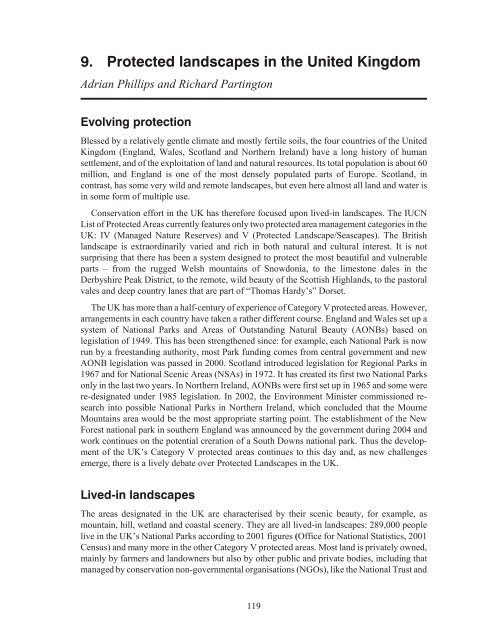The Protected Landscape Approach - Centre for Mediterranean ...
The Protected Landscape Approach - Centre for Mediterranean ...
The Protected Landscape Approach - Centre for Mediterranean ...
You also want an ePaper? Increase the reach of your titles
YUMPU automatically turns print PDFs into web optimized ePapers that Google loves.
9. <strong>Protected</strong> landscapes in the United Kingdom<br />
Adrian Phillips and Richard Partington<br />
Evolving protection<br />
Blessed by a relatively gentle climate and mostly fertile soils, the four countries of the United<br />
Kingdom (England, Wales, Scotland and Northern Ireland) have a long history of human<br />
settlement, and of the exploitation of land and natural resources. Its total population is about 60<br />
million, and England is one of the most densely populated parts of Europe. Scotland, in<br />
contrast, has some very wild and remote landscapes, but even here almost all land and water is<br />
in some <strong>for</strong>m of multiple use.<br />
Conservation ef<strong>for</strong>t in the UK has there<strong>for</strong>e focused upon lived-in landscapes. <strong>The</strong> IUCN<br />
List of <strong>Protected</strong> Areas currently features only two protected area management categories in the<br />
UK: IV (Managed Nature Reserves) and V (<strong>Protected</strong> <strong>Landscape</strong>/Seascapes). <strong>The</strong> British<br />
landscape is extraordinarily varied and rich in both natural and cultural interest. It is not<br />
surprising that there has been a system designed to protect the most beautiful and vulnerable<br />
parts – from the rugged Welsh mountains of Snowdonia, to the limestone dales in the<br />
Derbyshire Peak District, to the remote, wild beauty of the Scottish Highlands, to the pastoral<br />
vales and deep country lanes that are part of “Thomas Hardy’s” Dorset.<br />
<strong>The</strong> UK has more than a half-century of experience of Category V protected areas. However,<br />
arrangements in each country have taken a rather different course. England and Wales set up a<br />
system of National Parks and Areas of Outstanding Natural Beauty (AONBs) based on<br />
legislation of 1949. This has been strengthened since: <strong>for</strong> example, each National Park is now<br />
run by a freestanding authority, most Park funding comes from central government and new<br />
AONB legislation was passed in 2000. Scotland introduced legislation <strong>for</strong> Regional Parks in<br />
1967 and <strong>for</strong> National Scenic Areas (NSAs) in 1972. It has created its first two National Parks<br />
only in the last two years. In Northern Ireland, AONBs were first set up in 1965 and some were<br />
re-designated under 1985 legislation. In 2002, the Environment Minister commissioned re -<br />
search into possible National Parks in Northern Ireland, which concluded that the Mourne<br />
Mountains area would be the most appropriate starting point. <strong>The</strong> establishment of the New<br />
Forest national park in southern England was announced by the government during 2004 and<br />
work continues on the potential creration of a South Downs national park. Thus the develop -<br />
ment of the UK’s Category V protected areas continues to this day and, as new challenges<br />
emerge, there is a lively debate over <strong>Protected</strong> <strong>Landscape</strong>s in the UK.<br />
Lived-in landscapes<br />
<strong>The</strong> areas designated in the UK are characterised by their scenic beauty, <strong>for</strong> example, as<br />
mountain, hill, wetland and coastal scenery. <strong>The</strong>y are all lived-in landscapes: 289,000 people<br />
live in the UK’s National Parks according to 2001 figures (Office <strong>for</strong> National Statistics, 2001<br />
Census) and many more in the other Category V protected areas. Most land is privately owned,<br />
mainly by farmers and landowners but also by other public and private bodies, including that<br />
managed by conservation non-governmental organisations (NGOs), like the National Trust and<br />
119

















